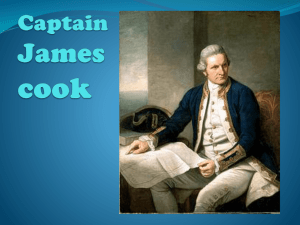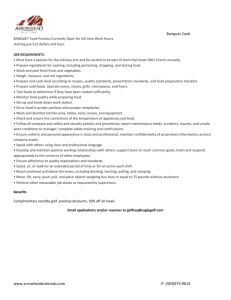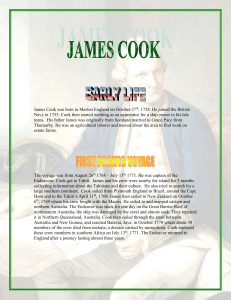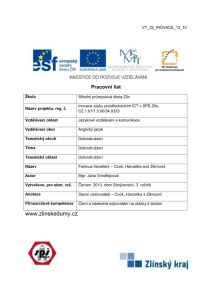Life at Sea in the Royal Navy of the 18th Century
advertisement
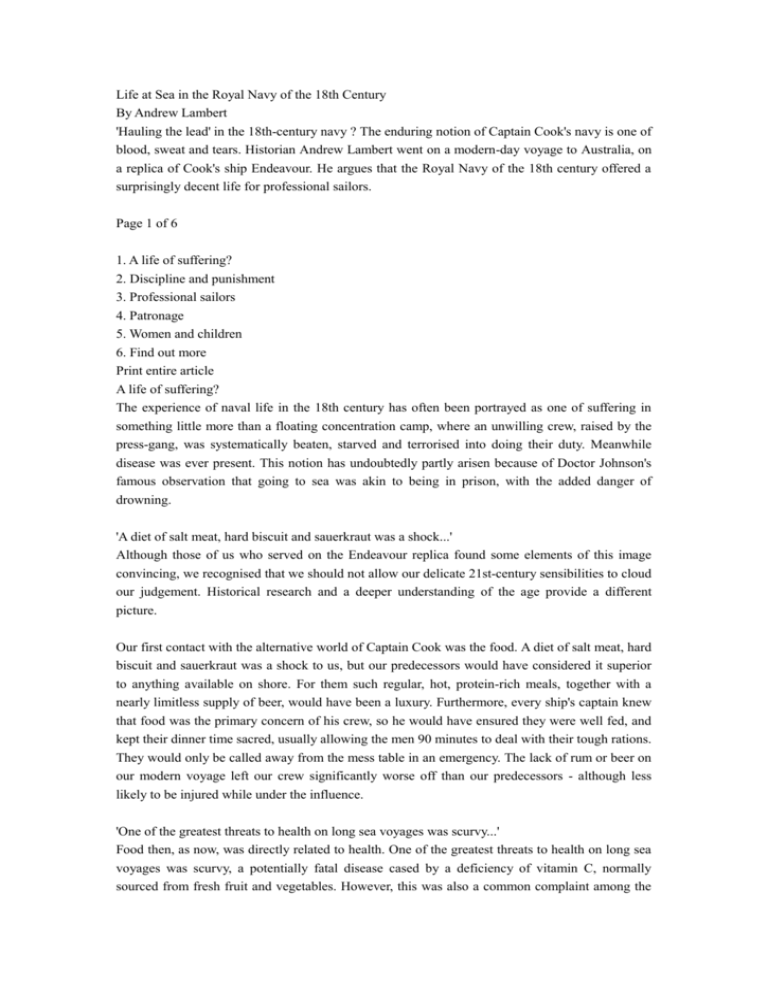
Life at Sea in the Royal Navy of the 18th Century By Andrew Lambert 'Hauling the lead' in the 18th-century navy ? The enduring notion of Captain Cook's navy is one of blood, sweat and tears. Historian Andrew Lambert went on a modern-day voyage to Australia, on a replica of Cook's ship Endeavour. He argues that the Royal Navy of the 18th century offered a surprisingly decent life for professional sailors. Page 1 of 6 1. A life of suffering? 2. Discipline and punishment 3. Professional sailors 4. Patronage 5. Women and children 6. Find out more Print entire article A life of suffering? The experience of naval life in the 18th century has often been portrayed as one of suffering in something little more than a floating concentration camp, where an unwilling crew, raised by the press-gang, was systematically beaten, starved and terrorised into doing their duty. Meanwhile disease was ever present. This notion has undoubtedly partly arisen because of Doctor Johnson's famous observation that going to sea was akin to being in prison, with the added danger of drowning. 'A diet of salt meat, hard biscuit and sauerkraut was a shock...' Although those of us who served on the Endeavour replica found some elements of this image convincing, we recognised that we should not allow our delicate 21st-century sensibilities to cloud our judgement. Historical research and a deeper understanding of the age provide a different picture. Our first contact with the alternative world of Captain Cook was the food. A diet of salt meat, hard biscuit and sauerkraut was a shock to us, but our predecessors would have considered it superior to anything available on shore. For them such regular, hot, protein-rich meals, together with a nearly limitless supply of beer, would have been a luxury. Furthermore, every ship's captain knew that food was the primary concern of his crew, so he would have ensured they were well fed, and kept their dinner time sacred, usually allowing the men 90 minutes to deal with their tough rations. They would only be called away from the mess table in an emergency. The lack of rum or beer on our modern voyage left our crew significantly worse off than our predecessors - although less likely to be injured while under the influence. 'One of the greatest threats to health on long sea voyages was scurvy...' Food then, as now, was directly related to health. One of the greatest threats to health on long sea voyages was scurvy, a potentially fatal disease cased by a deficiency of vitamin C, normally sourced from fresh fruit and vegetables. However, this was also a common complaint among the poor labourers on land in winter, when fresh food was scarce. Because the Royal Navy needed to operate around the world it made a huge effort to find a cure for scurvy, and on Cook's first voyage many remedies were tried, ranging from the infamous sauerkraut to extract of malt. Discipline and punishment Cook's determination to avoid deaths from scurvy, and his success, was a vital step in the creation of the British Empire. So important was the avoidance of the disease that Cook resorted to disciplinary measures to make his men eat their rations. We modern-day adventurers had to take a vitamin pill. Other diseases, such as dysentery and typhus, were avoided through an insistence on keeping the ship, the crew and their clothes clean - this cleanliness became a Royal Navy mania, and kept the sailors very busy. However, there were further medical terrors in store - malaria and yellow fever could decimate crews in tropical climates. In the modern age, discipline has become conflated with punishment, but in the 18th century it meant organisation; good discipline meant that the ship was well ordered, not that the men were soundly flogged. Men were punished, however, if they failed to do their duty, and put the ship and the rest of the crew in danger. Among the worst offences were falling asleep on duty, refusing to follow orders, or 'unclean behaviour' - such as relieving bodily functions inboard, rather than using the rudimentary toilet facilities. All of these offences threatened the safety of the ship and her crew. '...flogging with the cat-o'-nine-tails and hanging were the major punishments...' Contemporary naval punishments have become legendary, and strike us as inhuman; flogging with the cat-o'-nine-tails and hanging were the major punishments, while the men were occasionally 'started', or encouraged to work, with a blow from the end of a rope. There was no system of imprisonment, or financial penalty, although the rum ration could be stopped. However, we must remember that 18th-century society on shore relied on similar corporal and capital punishment. If anything, naval punishment was less severe, for sailors were a scarce and valuable resource that no captain would waste; also, flogging meant that the punishment was quickly completed, and the man could return to duty. There was no alternative, because the navy was, in all things, a reflection of the society it served. Formal punishments were always inflicted in public, using consciously theatrical methods to ensure the maximum deterrent effect. The crew would be formed up on deck, with the marines separating the officers from the seamen, while the punishment was carried out according to established custom. Some crimes were handled by the crew - thieves were forced to 'run the gauntlet', allowing their shipmates to strike them with rope ends. This was a highly effective means of deterring a man from committing any fundamental breach of the trust that had to subsist between men who literally depended upon each other for their lives. Professional sailors Sailors generally went to sea as boys. By the time they were 16 they could be rated as seamen, and normally served at sea for another ten years, before settling down and taking a shore or local sailing job. The idea of being single, free of responsibilities and well paid would have made a career at sea obviously alluring, but the attractions could also undoubtedly wear off, and only a small percentage of men stayed on at sea, rising to be naval petty officers and merchant shipmasters. In wartime the Royal Navy needed another 60,000 men to fit out the fleet, so it would draw in professional seamen from the merchant service, usually by impressment, an age-old right of the Crown to the labour of seafarers. As there were no spare seamen, however, both fleets sometimes needed the additional labour of landlubbers, attracted by the pay and opportunity, or of foreign sailors, who made up a significant proportion of all British crews. Cook had at least three such men on the Endeavour. The resulting dilution of skills was acceptable on large warships, where only 20 per cent of the crew was needed for skilled work aloft. The rest of the work, including the heavy hauling, was done by the 'landmen' or 'waisters' - those who worked in the waist area of the ship. '...their carefree, spendthrift and often riotous adventures led many to see them as simple, careless creatures...' By contrast, the prime seamen, rated as Able or Ordinary, saw themselves as an elite group within a vertically stratified working community. The topmen, who worked on the highest yards, spent much of their day aloft, in the tops, which on a battleship would be spacious areas out of sight of the officers, and far above the inferior members of the crew. They would form their own mess, a group of six to ten men who cooked and ate together, and avoided 'waisters', marines and other deck-bound labourers. To work aloft was to be among the elite of the 18th-century working class, and this was something that seamen delighted in advertising through their unique and colourful clothes, hairstyles, personal jewellery and - after contact with the Polynesian societies of the South Pacific - tattooing. This distinctive dress also marked them out when on shore, where their carefree, spendthrift and often riotous adventures led many to see them as simple, careless creatures and figures of fun. Yet this was a fundamental mistake. Professional sailors were skilled, daring and resourceful men. Their true worth was known to the state they served, and it was they, more than anything else, that gave Britain command of the sea. Patronage The social divisions of the navy were by no means class based. Not all officers were gentlemen. Some, like Cook, rose through the ranks of seaman and master to gain their position, others were admitted as officers despite humble origins. They had to pass formal examinations in all aspects of seamanship, and had to serve at least six years at sea before they could be commissioned as lieutenant, the rank at which Cook commanded the first voyage of the Endeavour. Further promotion to Commander and then Captain was through merit, bravery or patronage; Captains were promoted to Admiral through seniority. Patronage was an essential ingredient in the triumph of the 18th-century Royal Navy. It allowed the best officers, those who held the prime commands and won the key battles, to pick their followers. As professional men they chose juniors who would reflect credit on them, and secure them further victories, prize money and profit. Similarly, ambitious young officers sought the patronage of the best Admirals, those who could help them. Cook was brought into the officer corps as an act of patronage by Captain Hugh Palliser, himself an officer of humble origins, to command the first expedition. Cook had escaped his humble background, while Palliser basked in his reflected glory. For many years it was believed that women were rarely, if ever, allowed on board warships. This, like much else about life in the 18th-century Navy, was a Victorian invention that said more about the values of that time than it did about the realities of the previous century. In fact, large numbers of women went to sea. Usually they were the wives of the petty officers - mature women who played important roles, including those of providing medical treatment and handling ammunition. Women and children Not a few children were born on board warships, and some women entered under assumed male identities, although the fact that they were not discovered is very revealing of the low incidence of bathing among the seafarers, either on deck or in the sea. The 18th-century mind preferred homely dirt and the occasional clean shirt to the terrors of cold water or the deep ocean. Those women who were on board officially soon made their presence felt. In 1797 that crusty old martinet Admiral the Earl St Vincent issued an order demanding that they reduce their consumption of water. If not, he proposed sending them all home on the next transport. It is unlikely he gave them the separate bathing rights enjoyed by the female members of our modern-day replica crew. 'The 18th-century Royal Navy... won all the great battles at sea, and almost all the wars.' The 18th-century Royal Navy was the most effective fighting force in the world; it won all the great battles at sea, and almost all the wars. It did so because its ships carried well-organised, well-drilled and coherent teams, working to a common cause, bound together by ambition, mutual respect and a shared identity. The crews of British warships handled their sails and fired their guns more quickly than their rivals. The British also kept their ships cleaner, helping to reduce losses to disease. As in all large organisations there were exceptions - bad officers, bad men and bad ships but such exceptions were rare. The fleet at sea was supported by the world's largest industrial base, a massive infrastructure of dockyards, food stores and equipment warehouses, all funded by a generous nation that saw its future as dependent on the seas. The voyages of Captain Cook expanded our understanding of those seas, and our ability to travel across them in safety, both because of his superior navigational skills and because of his understanding of disease prevention. His mission was fundamentally practical. The modern-day replica Endeavour was a happy, efficient ship for most of our long voyage, and it was a privilege to help make that voyage possible, capturing a flavour of the experiences of Captain Cook and his crew. Find out more Books The Ship - Retracing Cook's Endeavour Voyage by Simon Baker (BBC Worldwide, 2002) War at Sea in the Age of Sail by A D Lambert (Cassell, 2000) Shipboard Life and Organisation, 1731-1815 edited by B Lavery (Navy Records Society, 1998) The Wooden World: An Anatomy of the Georgian Navy by NAM Rodger(many editions since 1986, including WW Norton & Co, 1996) Links The National Maritime Museum The Royal Naval Museum [The BBC is not responsible for the content of external websites.] About the author Andrew Lambert is Laughton Professor of Naval History at King's College, London. His three-part television series War at Sea was broadcast on BBC TWO in 2004.
